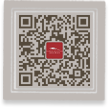- 中文
- EN
- Français
- 日本語
- 한국어
- 繁體中文
The Exhibition “Infinite Beauty—Literature and Female Images in Figure Paintings of the Ming and Qing Dynasties” Launched in the Hunan Museum
On June 23, the exhibition “Infinite Beauty—Literature and Female Images in Figure Paintings of the Ming and Qing Dynasties” was opened in the Art Hall of Hunan Museum. Over one hundred representatives attended the opening ceremony, including leaders and experts from the Hunan Provincial Bureau of Cultural Heritage, the Hunan Provincial Federation of Literary and Art Circles, the Hunan Provincial Artists Association, the Hunan Provincial Calligraphers Association, the Hunan Provincial Writers Association, the Changsha Federation of Literary and Art Circles, the Hunan Provincial Institute of Cultural Relics and Archaeology, the Hunan Fine Arts Publishing House, the Changsha Academy of Painting, the Changsha Education College, the Changsha Institute of Educational Science, the Changsha Museum, the Changsha Jiandu Museum, members of the leadership team, curatorial teams, senior members and volunteers of the Hunan Museum, as well as representatives from the central and provincial news media.
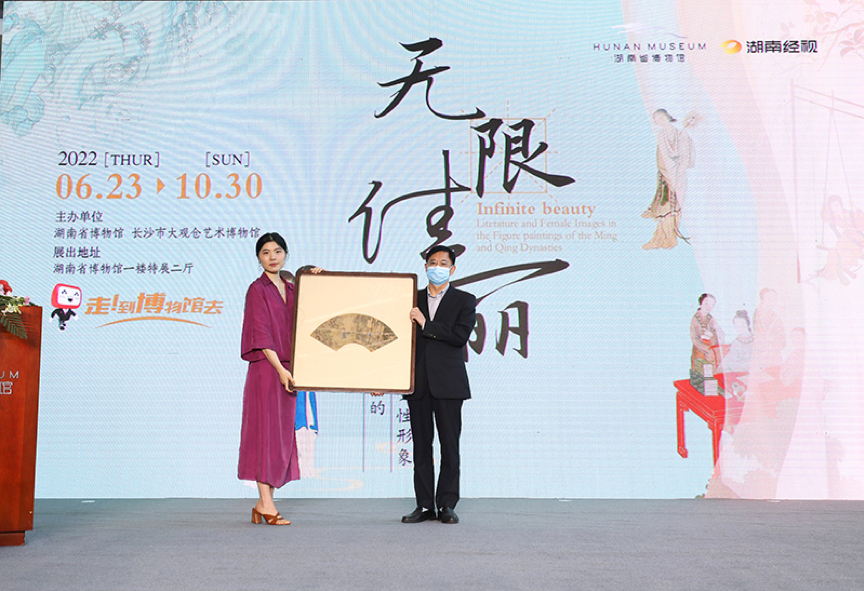
At the opening ceremony, leaders and experts from the Hunan Provincial Bureau of Cultural Heritage, the Hunan Museum, the Changsha Daguancang Art Museum and other museums and cultural institutions delivered speeches respectively. Moreover, the Changsha Daguancang Art Museum donated a precious painting and calligraphy collection to the Hunan Museum.
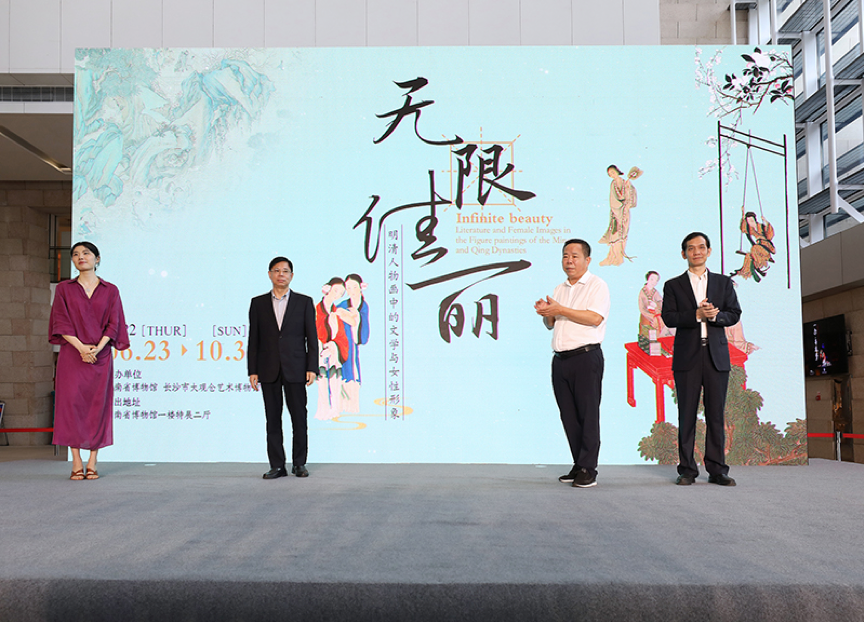
The exhibition, “Infinite Beauty—Literature and Female Images in Figure Paintings of the Ming and Qing Dynasties”,was jointly organized by the Hunan Museum and the Changsha Daguancang Art Museum. It is an important original art exhibition of painting and calligraphy of the Hunan Museum in 2022. The exhibition displays more than 120 pieces (sets) of various cultural relics collected by the Hunan Museum and the Changsha Daguancang Art Museum, including painting and calligraphy, bronzes, ceramics, embroidery and other categories. Among them, more than 30 pieces (sets) of cultural relics were exhibited in the Hunan Museum, and more than 90 pieces (sets) of collections were exhibited in the Changsha Daguancang Art Museum.

This exhibition expounds the multiple social roles played by ancient women, their self-cultivation and their awareness of family and country, showing the literature and art in figure paintings of the Ming and Qing dynasties to the public. It is composed of four parts: “Which Woman in the World Can Be As Virtuous As You—Wisdom of Running a Family”, “Women Are No Inferior to Men—Family-Country Consciousness”, “Treat All Beings with Compassion and Softness—The Blessing of Goddess” and “The Best and Most Elegant Flowers—Gorgeous Women”. The first part expresses the contribution of ancient women to their families, the second part demonstrates the realization of ancient women’s social values, the third part conveys the influence of women’s spiritual power on the world, and the fourth part interprets the awakening of women’s self-consciousness. These four parts together show the tough image of ancient women vividly.

Part one: The Book of Changes says, “The essence of Qian determines the hard side of things, and the essence of Kun determines the soft side of things. The masculinity of Qian and the softness of Kun determine the generation and development of everything”. Men and women were like heaven and earth, each bearing its own weight, and there was no hierarchy between them. Human history was a play acted by both men and women. However, due to the limitations of historical and social environment, the roles of ancient women were mostly limited to the family, trapped under a small roof, and regarded as males’ appendage. Nevertheless, they were smart, tolerant and tenacious. Ancient women not only performed their family functions deeply and widely, but also had a far-reaching impact on family members thanks to their moral integrity.

Part two: Although the outstanding women in ancient China were trapped in the barriers of family and society, many of them still made great achievements in politics, economy, culture, art and other aspects with their extraordinary talents, which had an immeasurable impact, such as Wang Zhaojun, who traveled thousands of miles to marry the king of Xiongnu, so as to make peace with rulers of minority nationalities in the border areas; Hua Mulan, who disguised herself as a man and joined the army on behalf of her father; Yang Yuhuan, most favored in the harem, hanged herself in Maweiyi; Hong Xiannu, who had a unparalleled strong sense of justice and ready to help the weak; Shisan Mei, who punished the evildoers and eliminate the wicked for the people. These excellent female images and stories in figure paintings of the Ming and Qing dynasties are either false or real, but they are the indicators and traces of women’s participation in social activities, silently telling the world: “Women are just as good as men, and they can perform better than males.”
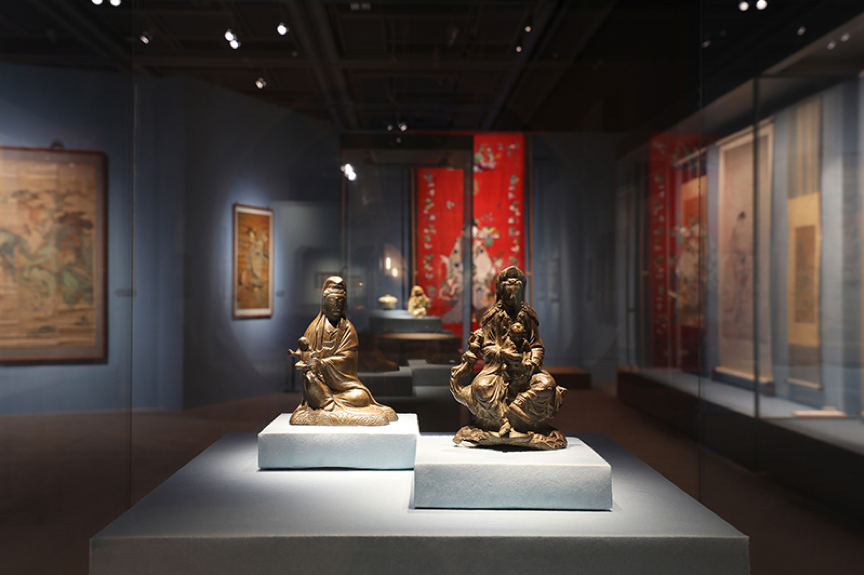
Part three: In traditional Chinese society, women were usually attached to men and were regarded as too weak to leave the house. However, the motherhood that breeds life, the dedication of kindness and self-sacrifice, the affinity of understanding, and the compassion to save people from suffering have made some “weak” females be worshiped as deity. They have become not only the “spiritual mother” who protects women and children, but also the strong spiritual pillar for thousands of devout men and women to place their hopes for a better life.
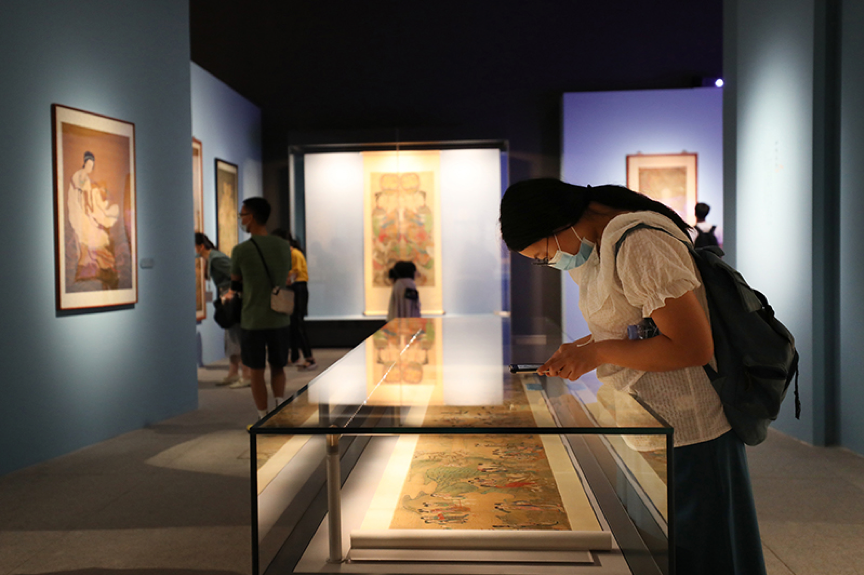
Part four: Traditional society is a structure dominated by men. It was not until the ideological liberation movement in the Ming and Qing dynasties that women began to have the initiation of subject consciousness. During this period, the number of female theme paintings and female painters was far more than previous dynasties, and the extension of the theme of the works continued to expand, which allowed the existence of women’s own aesthetic and value evaluation system, and showed their increasingly rich social identity and roles more inclusively. This laid a preliminary foundation for women to get out of the boudoir and enter the society in the future and break free from the shackles of thought.

The exhibition also adopts digital technology to carry out a dialogue between classical and contemporary world, inside and outside the paintings, and between individuals and groups for visitors. It utilizes three-dimensional modeling technology, and through the motion roaming of the lens, the two-dimensional scenes in Spring Morning in the Han Palace, such as playing Cuju, playing the piano, teasing birds, playing chess and so on, are presented to the audience in an immersive way. There are also static picture devices and supporting AR images themed at Nymph of the Luo River, and visitors can scan the QR code to enter the mini program to enjoy the multi-level 3D effect of the work. In addition, in order to enhance interaction, this very exhibition is equipped with motion interactive equipment, integrates the fairy roles in ancient paintings with the aesthetic style of cyberpunk, and dynamically presents traditional images such as 33 images of Guanyin, Magu, Luo Shen, etc. On-site visitors can go there and touch the characters on the screen to experience the digital dynamic form of blessing-draw lots.
The exhibition is open to the public from June 23 to October 30 in the special exhibition hall of the Hunan Museum. Visitors can log in to the official WeChat platform or Alipay mini program of the Hunan Museum to buy tickets and enter the museum through a special access.



